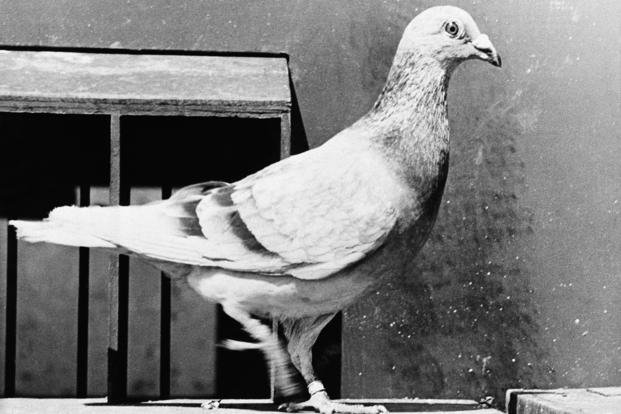Less than a month before the guns of World War I fell silent, American soldiers from the 28th Infantry Division overtook a German trench line in the Argonne Forest in France. Of the prisoners of war they captured, one had a very special mission -- and weighed less than a pound.
That POW was a homing pigeon, who U.S. soldiers named Kaiser after Kaiser Wilhelm II, the last German emperor. Realizing the value of sending messages by pigeons when radio communication proved problematic, the Allied and Axis powers had employed a combined total of roughly 100,000 pigeons during the course of World War I. The Germans even used pigeons to relay information to the front lines after retiring to the Hindenburg Line in 1917.
Kaiser was not so much treated as a prisoner during his time in American custody as an honored guest and became beloved in what became his adopted homeland of the United States at the end of the war. “Once in America, Kaiser was paraded with other captured birds and used for recruiting purposes in 1919 before settling in at the Signal Corps Pigeon Center in Fort Monmouth, New Jersey,” according to National Museum of American History (NMAH) curator Frank Blazich.
This notable pigeon's life, though, began innocently enough in western Germany in February 1917. Just getting used to his new surroundings, Kaiser was outfitted with an aluminum band (No. 17-0350-47) around his left leg and handed over to the German army at six weeks old.
Even at such a young age, Kaiser was an asset. Homing pigeons, also known as carrier or racing pigeons, can achieve speeds approaching 70-90 mph and fly hundreds of miles in a day. With their acute sense of direction, they are believed to have been first used as messengers in the fifth century BC. In the 20th century, they proved especially useful during wartime, bringing back photographic intelligence and completing vital tasks when released from tanks, bombers, aircraft carriers and seaplanes.
“These extraordinary birds carried messages in and out of gas, smoke, exploding bombs and gunfire,” author Elizabeth Macalaster wrote in the book “War Pigeons: Winged Couriers in the U.S. Military, 1878-1957.” “They flew through jungles, deserts and mountains, not faltering even when faced with large expanses of ocean to cross. Sometimes they arrived nearly dead from wounds or exhaustion, refusing to give up until they reached their objective.”
The U.S. Army Signal Corps' pigeon service debuted in France in 1918. By the time the Meuse-Argonne Offensive began in September of that year, U.S. forces were using nearly 450 U.S. pigeons.
Kaiser’s post-WWI contributions to the U.S. military went beyond simply morale and public relations functions. At an age when most pigeons would have been long dead, Kaiser was still breeding by the time the U.S. entered World War II. After the Army Signal Corps moved its pigeon program to Camp Crowder, Missouri, in late 1943, ol' Kaiser -- even at his advanced age -- fathered an amazing seven young squeakers in one year.
“His keepers maintained that his offspring would be weak -- useless for raceless pigeons,” according to author Carl Naether’s “The Book of the Racing Pigeon.” “How great was their chagrin when one of them, ‘Little Caesar,’ won a 320-mile race from Dallas to Camp Crowder, Missouri, in competition with some of the army’s best flyers.”
By 1945, Kaiser had become the proud papa of more than 75 offspring -- many of which helped deliver messages in Europe and the Pacific.
Kaiser eventually outlived all of the other POW pigeons in the U.S. from WWI. When Kaiser was relocated to Camp Crowder, the accommodations were befitting of a pigeon of his age and status. Military personnel even furnished "the loft with an electric heater to make cold nights cozier for Kaiser and Lady Belle," his mate, according to the NMAH.
Kaiser returned to Fort Monmouth after the war, but the fun didn't stop there. In his retirement, he was celebrated with a party on his 31st birthday, became an honorary member of an American Legion post in Los Angeles and attended President Harry Truman’s inauguration in 1949. Kaiser eventually died on Halloween night in 1949. His remains are displayed at the Smithsonian Institution.
"His bloodline provided the U.S. Army with countless homing pigeons in World War II," Blazich, the NMAH curator, wrote. "The progeny of his great-great-great-great grandchildren, sold to the public when the Army disestablished the pigeon service in 1957, remain in lofts across the U.S., undoubtedly still producing racing champions."
-- Stephen Ruiz can be reached at stephen.ruiz@military.com.
Want to Know More About the Military?
Be sure to get the latest news about the U.S. military, as well as critical info about how to join and all the benefits of service. Subscribe to Military.com and receive customized updates delivered straight to your inbox.
















